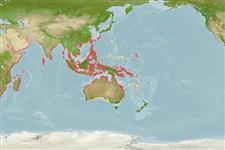>
Beloniformes (Needle fishes) >
Belonidae (Needlefishes)
Etymology: Strongylura: Greek, strongylos = round + Greek, oura = tail (Ref. 45335).
More on author: Bleeker.
Environment: milieu / climate zone / depth range / distribution range
Ecologie
marien; brak water rifbewoner; oceanodroom (Ref. 51243); diepte 0 - 3 m (Ref. 86942). Tropical; 30°N - 40°S, 30°E - 180°E
Indo-West Pacific: Somalia (Ref. 30573) and Tanzania to Durban, South Africa (Ref. 3130) east to Pakistan, India, Sri Lanka and southeast Asia to New Guinea, Australia, and the Philippines. Reported from southern China (Ref. 5317). The Australian population is regarded as subspecies Strongylura leiura ferox by Parin (1967) (Ref. 1602).
Grootte / Gewicht / Leeftijd
Maturity: Lm ? range ? - ? cm
Max length : 100.0 cm TL mannelijk / geslacht onbekend; (Ref. 3678); common length : 35.0 cm OT mannelijk / geslacht onbekend; (Ref. 9682)
Dorsale stekels (totaal): 0; Dorsale zachte stralen (totaal): 17-21; Anale stekels 0; Anale zachte stralen: 23 - 25. Laterally compressed; origin of dorsal fin over 7th-10th ray of anal fin; dorsal fin rays 17-21; anal fin rays 23-25; caudal peduncle without lateral keels; caudal fin emarginate; predorsal scales moderately small, 130-180 (Ref. 9682). Caudal fin sub truncate; a black bar on cheek between opercle and preopercle; greenish dorsally, grading to silvery white ventrally.
Inhabit coastal waters and estuaries (Ref. 5213). Larvae and early juveniles are found in mangroves (Ref. 43081). Feed mainly on small fishes (Ref. 3130) and crustaceans (Ref. 43081). Oviparous (Ref. 205). Eggs may be found attached to objects in the water by tendrils on the egg's surface (Ref. 205). Marketed fresh (Ref. 9682).
Levenscyclus en paargedrag
Maturiteit | Voortplanting | Paaien | Eieren | Fecunditeit | Larven
Randall, J.E., G.R. Allen and R.C. Steene, 1990. Fishes of the Great Barrier Reef and Coral Sea. University of Hawaii Press, Honolulu, Hawaii. 506 p. (Ref. 2334)
Status op de Rode Lijst van het IUCN (Ref. 130435)
Gevaar voor de mens
Harmless
Gebruik door de mens
Visserij: commercieel; sportvis: ja
Tools
Speciale rapporten
Download XML
Internetbronnen
Estimates based on models
Preferred temperature (Ref.
123201): 24.7 - 29.3, mean 28.5 °C (based on 2798 cells).
Fylogenetische diversiteitsindex (Ref.
82804): PD
50 = 0.5001 [Uniqueness, from 0.5 = low to 2.0 = high].
Bayesian length-weight: a=0.00148 (0.00077 - 0.00285), b=3.06 (2.90 - 3.22), in cm total length, based on LWR estimates for this species & Genus-body shape (Ref.
93245).
Trofisch niveau (Ref.
69278): 3.9 ±0.64 se; based on food items.
Weerstandsvermogen (Ref.
120179): Gemiddeld, minimale populatieverdubbelingstijd 1,4-4,4 jaar (Preliminary K or Fecundity.).
Fishing Vulnerability (Ref.
59153): High vulnerability (60 of 100).
Nutrients (Ref.
124155): Calcium = 54.1 [17.3, 251.2] mg/100g; Iron = 0.425 [0.198, 1.184] mg/100g; Protein = 17.6 [15.6, 19.7] %; Omega3 = 0.103 [0.041, 0.287] g/100g; Selenium = 25.4 [11.8, 57.8] μg/100g; VitaminA = 72.1 [21.3, 254.1] μg/100g; Zinc = 1.11 [0.71, 1.73] mg/100g (wet weight);
